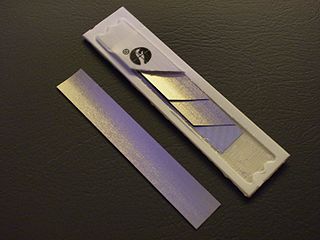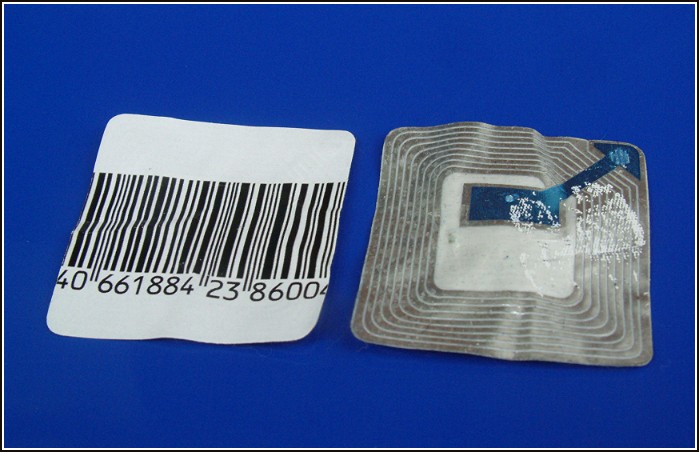Background reading: electronic article surveillance
In my previous blog post, I mentioned a couple of techniques that are used in electronic article surveillance (or: EAS). Some readers were unfamiliar with these terms. Therefore, in this post you can find some background information about a couple of techniques used in electronic article surveillance.
Acousto-magnetic

The most simple tag that is still found nowadays is the acousto-magnetic tag[Vitag]. It consists of two metal strips with specific magnetic properties, surrounded with plastic. These two strips can move freely and oscillate mechanically at their resonance frequency. In practice, a tag detector sends out bursts of 58 kHz tones that trigger this oscillation. After such a burst, the tag continues to oscillate for a period of time. The tag detector notices a change in its magnetic field and, if requirements such as frequency, repetition and level of the signal are met, an alarm goes off.
In the image, we can see the dissection of an acousto-magnetic tag. One of the metal strips is cut out (left) to expose the other strip. Activation and deactivation of the tag is done using magnetization and demagnetization, respectively. These tags are typically used in clothing.
RF (Radio Frequency)

RF tags work in a somewhat different way. Internally, they have a coil (or antenna) and a capacitor (or “battery”) that form an LC-circuit[LC]. Such a circuit resonates when it receives a specific frequency (depending on the properties of both the coil and the capacitor). You can see the coil in the form of rounded circles on the right-hand side in the picture. The capacitor is, most likely, the blue part in the middle and the diagonal to the top right.
These tags typically resonate at a frequency between 1.75 MHz and 9.5 MHz[EAS]. Given its rather flat build, RF tags are typically incorporated in labels, e.g. behind barcodes. In that way, both identification of an item (through the barcode) and detection of theft (through the RF tag) can be done simultaneously. Typical items that have these RF tags are library books, rental videos, etc.
Both the acousto-magnetic and the RF tag do not carry nor emit any identifying information, such as a serial or identification number. Their sole purpose is to provide detection of unauthorized movement of items (commonly known as ‘theft’).
RFID (Radio Frequency IDentification)
We have seen two types of tags that provide theft control in a binary way: an article is “sold” or “not sold”. They do not provide any means1 of indicating what article has left the store. In some cases, a retailer might want to have stricter inventory management, such that he knows what product and when it is sold (to whom, perhaps). RFID tags contain a unique identifier that they emit when activated.
RFID tags can operate on various frequencies, for different purposes. They can be active or passive. Passive tags are activated through radio waves emitted from an RFID reader. These tags are relatively cheap, because they do not require a power source. Their reading range, however, is also limited: about 1cm up to 1 meter, depending on the reader and the tag’s frequency. Active tags have their own power source. Consequently, they have a larger read-out range (up to a couple of hundred meters) and can be read by passive reader.
In retail, RFID tags are used to track products from the moment they enter the store until they leave. Modern systems can even pinpoint the location of an item while in the store (see the iSense Lumen I mentioned in my previous blog post)
RFID tags may have some user writable memory. For example, the Dutch “OV-Chipkaart” (compare the London Oyster card) is used to pay for public transport. Users can top up their balance and pay for their trips. Other types of cards have microcontrollers (such as access cards) or are complete smart cards (such as EMV / bank cards).
References
- [Vitag] Vitag - System types
- Image in acousto-magnetic section from Wikimedia Commons
- Image in RF section from Wikimedia Commons. CC-BY Anton~commonswiki
- [LC] “LC Circuit” on Wikipedia
- [EAS] “Electronic article surveillance” on Wikipedia
-
RF tags may resonate at different frequencies, which can be used to identify a type of product. Cheap products could, for example, use a low frequency, while expensive products use a high frequency. ↩